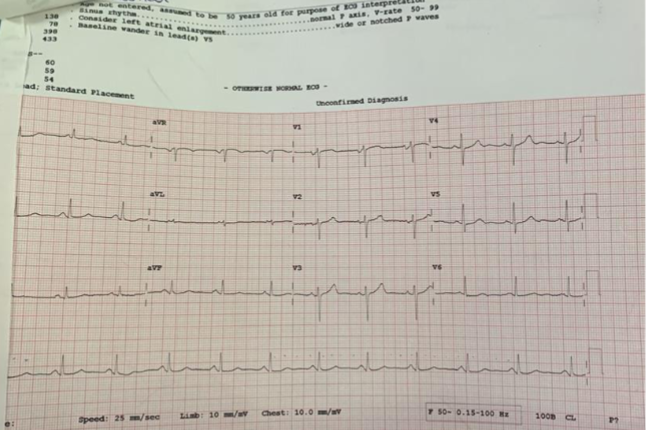A Case Report of Diarrhea-Induced Atrial Fibrillation
Main Article Content
Abstract
E.coli-induced diarrheal infection usually presents milder symptoms and recovers with antibiotics. But this case presents with atrial fibrillation, instead of ventricular arrhythmias which is the rarest complication of low potassium. The most prevalent sustained arrhythmia in older adults is atrial fibrillation. A three- to five-fold greater risk of stroke is linked to atrial fibrillation, as well as a greater risk of heart failure, cardiac mortality, and overall mortality. Hypokalemia (3.5 mmol/l), or low serum potassium, is thought to increase the risk of cardiovascular illness, particularly ventricular arrhythmias and cardiac arrest. The relationship between serum potassium levels and the risk of atrial fibrillation has only been briefly studied in the past. When E. coli causes diarrhoea, Low serum potassium, which is connected to a lengthening of P waves, a measure of atrial conduction. Atrial fibrillation risk has been linked to an increase in P-wave duration.
Article Details
References
Wolf PA, Abbott RD, Kannel WB. Atrial fibrillation as an independent risk factor for stroke: the framingham study. Stroke 1991;22:983–8.
Wang TJ, Larson MG, Levy D, et al. Temporal relations of atrial fibrillation and congestive heart failure and their joint influence on mortality: the framingham heart study. Circulation 2003;107:2920–5.
Benjamin EJ, Wolf PA, D'Agostino RB, Silbershatz H, Kannel WB, Levy D. Impact of atrial fibrillation on the risk of death: the framingham heart study. Circulation 1998;98:946–52.
Macdonald JE, Struthers AD. What is the optimal serum potassium level in cardiovascular patients? J Am Coll Cardiol 2004;43:155–61. [5] Wahr JA, Parks R, Boisvert D, et al. Preoperative serum potassium level
Severi S, Pogliani D, Fantini G, et al. Alterations of atrial electrophysiology induced by electrolyte variations: combined computational and p-wave analysis. Europace 2010;12:842–9.
Agarwal YK, Aronow WS, Levy JA, Spodick DH. Association of interatrial block with development of atrial fibrillation. Am J Cardiol 2003;91:882.
Magnani JW, Johnson VM, Sullivan LM, et al. P wave duration and risk of longitudinal atrial fibrillation in persons N/= 60 years old (from the framingham heart study). Am J Cardiol 2011;107:917–21 [e911].
Ciaroni S, Cuenoud L, Bloch A. Clinical study to investigate the predictive parameters for the onset of atrial fibrillation in patients with essential hypertension. Am Heart J 2000;139:814–9.
De Bacquer D, Willekens J, De Backer G. Long-term prognostic value of p-wave characteristics for the development of atrial fibrillation in subjects aged 55 to 74 years at baseline. Am J Cardiol 2007;100:850–4.
Baykan M, Celik S, Erdol C, et al. Effects of p-wave dispersion on atrial fibrillation in patients with acute anterior wall myocardial infarction. Ann Noninvasive Electrocardiol 2003;8:101–6.
Field M, Graf LH Jr, Laird WJ, Smith PL: Heat-stable enterotoxin of Escherichia coli: In vitro effects on guanylate cyclase activity, cyclic GMP concentration, and ion transport in small intestine. Proc Natl Acad Sci U S A75 :2800– 2804,1978 Abstract/FREE Full TextGoogle Scholar
Gennari FJ. Hypokalemia.N Engl J Med. 1998; 339:451–458. doi: 10.1056/NEJM199808133390707CrossrefMedlineGoogle Scholar
Krijthe BP, Heeringa J, Kors JA, Hofman A, Franco OH, Witteman JC, Stricker BH. Serum potassium levels and the risk of atrial fibrillation: the Rotterdam Study.Int J Cardiol. 2013; 168:5411–5415. doi: 10.1016/j.ijcard.2013.08.048CrossrefMedlineGoogle Scholar
Morotti S, McCulloch AD, Bers DM, Edwards AG, Grandi E. Atrial-selective targeting of arrhythmogenic phase-3 early afterdepolarizations in human myocytes.J Mol Cell Cardiol. 2016; 96:63–71. doi: 10.1016/j.yjmcc.2015.07.030CrossrefMedlineGoogle Scholar
Edwards AG, Grandi E, Hake JE, Patel S, Li P, Miyamoto S, Omens JH, Heller Brown J, Bers DM, McCulloch AD. Nonequilibrium reactivation of Na+ current drives early afterdepolarizations in mouse ventricle.Circ Arrhythm Electrophysiol. 2014; 7:1205–1213. doi: 10.1161/CIRCEP.113.001666 LinkGoogle Scholar

